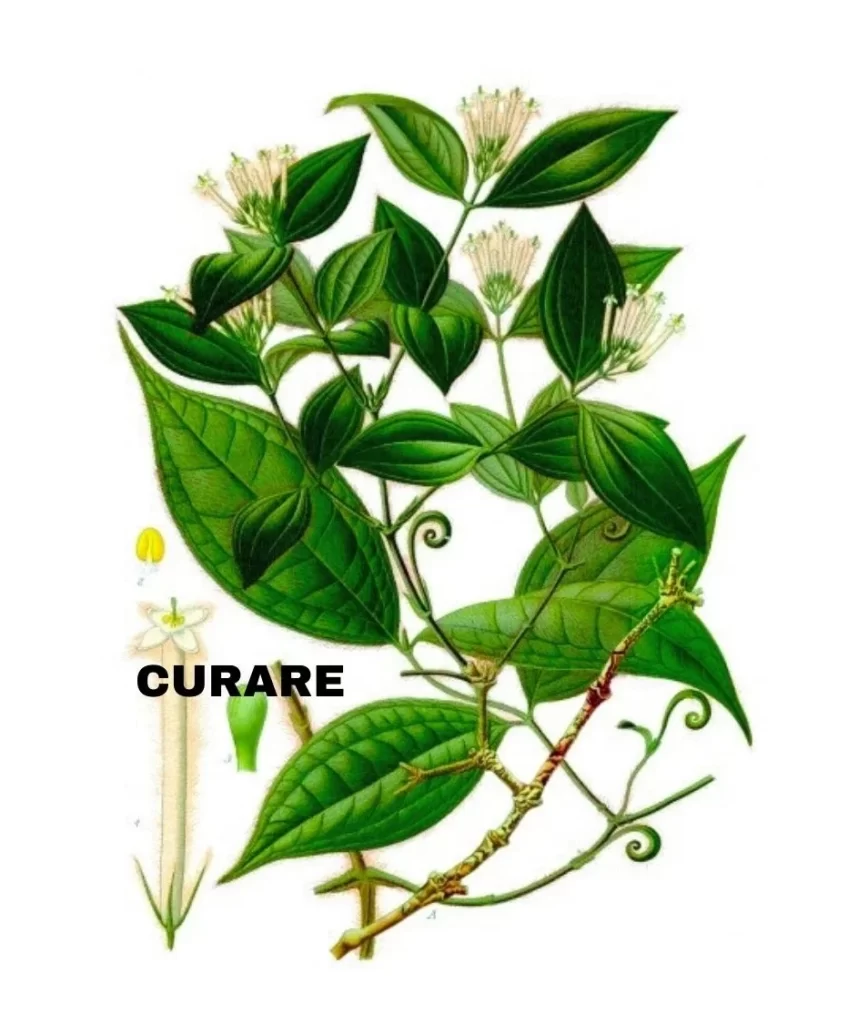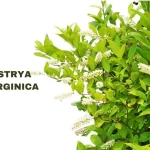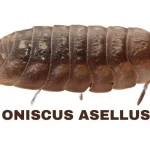Curare, also known as arrow-poison or Woorari, is a potent plant-derived substance used historically by indigenous tribes in South America for hunting purposes.
It is renowned for its ability to induce muscular paralysis while leaving sensation and consciousness intact.
In homoeopathy, Curare is used as a remedy for various conditions characterised by muscular weakness, paralysis, and nervous debility.

Table of Contents
ToggleSOURCE INFORMATION
Scientific Classification
- Kingdom: Plantae
- Order: Ranunculales
- Family: Menispermaceae
- Genus: Chondrodendron
- Species: Several species within the Chondrodendron genus are used to produce Curare, including Chondrodendron tomentosum and Chondrodendron amazonicum.
Origin
- Curare originates from the tropical rainforests of South America, particularly the Amazon basin.
- Indigenous tribes in the region, such as the Waorani people of Ecuador and the Tukano tribes of Brazil, have used Curare for centuries as a hunting poison.
Historical Significance
- Curare has a long history of use among indigenous peoples of South America.
- It was traditionally prepared by boiling and reducing the juices of certain plants, including Chondrodendron species, to create a thick, black, resinous substance.
- This potent poison was then applied to arrowheads or blowgun darts for hunting large game such as monkeys and birds.
Botanical Description
- Chondrodendron species are woody vines or shrubs that climb trees in the rainforest canopy.
- They produce clusters of small, greenish flowers and fleshy fruits containing seeds.
- The plants contain alkaloids, particularly d-tubocurarine, which are responsible for the paralyzing effects of Curare.
Cultural and Ethnobotanical Importance
- Curare holds significant cultural and ethnobotanical importance among indigenous tribes of the Amazon.
- It is considered a vital tool for hunting and has been passed down through generations as traditional knowledge.
- Curare’s use in hunting has also attracted the interest of Western explorers and scientists, leading to its study and eventual incorporation into modern medicine.
Medicinal Use
- In addition to its historical use as a hunting poison, Curare has been studied for its potential medicinal applications.
- In modern medicine, d-tubocurarine, one of the active alkaloids in Curare, is used as a neuromuscular blocking agent during anaesthesia to induce muscle relaxation and paralysis.
DRUG PATHOGENESIS
- Curare acts primarily on the neuromuscular junction, where it competitively blocks the action of acetylcholine, a neurotransmitter responsible for muscle contraction.
- By preventing the binding of acetylcholine to its receptors on muscle cells, Curare induces muscular paralysis without affecting sensation or consciousness.
- The paralysis induced by Curare is characterised by a loss of voluntary muscle control, weakness, and trembling.
- It primarily affects the respiratory muscles, leading to respiratory paralysis and potentially life-threatening respiratory failure.
- Curare also influences the central nervous system, causing symptoms such as indecision, lancinating pains in the head, and sensory disturbances such as black spots before vision.
- Its effects on the respiratory system can result in dyspnea (shortness of breath), dry cough, and chest soreness, exacerbating respiratory distress.
KEY CHARACTERISTICS
HEAD
- Lancinating pains: Sudden, sharp pains spread throughout the head.
- Sensation of fullness in the brain: Feeling of pressure or heaviness in the head.
- Falling out of hair: Hair loss or shedding.
EYES
- Sharp, stitching pains over the right eye: Acute, stabbing pains specifically felt on the right side of the eye.
- Black spots before vision: Visual disturbances characterized by dark spots or floaters in the field of vision.
- Drooping of the eyelid (ptosis) on the right side: Drooping or sagging of the upper eyelid on the right side.
EARS
- Unbearable earache: Intense pain in the ears.
- Lancinating pains starting from the ears and extending down to the legs: Sudden, sharp pains originating from the ears and radiating down to the legs.
- Swelling of the ear lobes: Enlargement or puffiness of the earlobes.
NOSE
- Ozena (foul-smelling discharge from the nose): Chronic nasal condition characterised by a foul-smelling discharge.
- Tubercles on the nose with foetid pus: Small, rounded swellings on the nose producing foul-smelling pus.
FACE
- Facial and buccal paralysis: Paralysis affecting the facial muscles and cheeks.
- Tongue and mouth drawn to the right side: Deviation or pulling of the tongue and mouth towards the right side.
RESPIRATORY
- Threatened paralysis of respiration on falling asleep: Risk of respiratory muscle paralysis upon falling asleep.
- Shortness of breath: Difficulty breathing or breathlessness.
- Dry cough provoking vomiting: Persistent cough that triggers vomiting.
- Dyspnea (difficulty breathing): Laboured or difficult breathing.
EXTREMITIES
- Weakness and heaviness in the arms: Feeling of weakness and weightiness in the arms.
- Inability to lift the fingers: Difficulty in raising or moving the fingers.
- Trembling legs: Shaking or trembling of the legs.
- Debility and paralysis of the extremities: Weakness and loss of movement in the limbs.
MODALITIES
- Aggravation: Dampness, cold weather, cold wind, and around 2 am; symptoms are worse on the right side.
- Amelioration: Warmth and rest.
RELATIONSHIP WITH OTHER DRUGS
- Compare with: Cystisin (for motor paralysis), Conium, Causticum, Crotalus, and Nux vomica.
- Curare antidotes Strychnine poisoning.
DOSE
- Sixth to thirtieth potency.
Frequently Asked Questions
What is Curare used for in homoeopathy?
- Curare is used primarily for conditions characterised by muscular weakness, paralysis, and respiratory distress, such as paralysis of respiratory muscles, trismus (lockjaw), and nervous debility.
Is Curare safe to use?
- When prepared according to homoeopathic principles and administered in appropriate potencies, Curare is considered safe for use.
- However, it should only be used under the supervision of a qualified homoeopathic practitioner.
Can Curare be used for respiratory conditions?
- Yes, Curare may be indicated for respiratory conditions characterised by paralysis of respiratory muscles, dyspnea, and dry cough provoking vomiting.
- It can help relieve respiratory distress and promote relaxation of the chest muscles.
How should Curare be taken?
- Curare is typically taken in the form of homoeopathic dilutions (potencies) ranging from the sixth to thirtieth potency.
- It should be administered according to the individual’s specific symptoms and constitution, as determined by a homoeopathic practitioner.
Are there any side effects of Curare?
- When used according to homoeopathic principles and in appropriate potencies, Curare is generally well-tolerated and does not cause significant side effects.
- However, as with any homoeopathic remedy, individual sensitivity and reaction may vary.
Meaning of Difficult Words
- Catalepsy: A condition characterised by a trance-like state, rigid posture, and loss of voluntary movement.
- Trismus: Lockjaw, a condition in which the jaw muscles spasm and contract, making it difficult to open the mouth.
- Ozena: A chronic inflammatory condition of the nasal mucosa characterised by foul-smelling discharge and nasal obstruction.
- Ptosis: Drooping of the eyelid due to weakness or paralysis of the muscles that lift the eyelid.
- Lancinating: Describing a sudden, sharp, stabbing pain.
- Dyspnea: Difficulty breathing or shortness of breath.
- Debility: Weakness or lack of strength, often associated with illness or age-related decline.
- Foetid: Foul-smelling or having a strong, unpleasant odour.
- Tubercles: Small, rounded swellings or growths, often found in clusters.
- Paralysis: Loss of muscle function or movement due to damage or dysfunction of the nervous system.
- Anthelmintic: A substance used to expel or destroy parasitic worms.













Leave a Reply